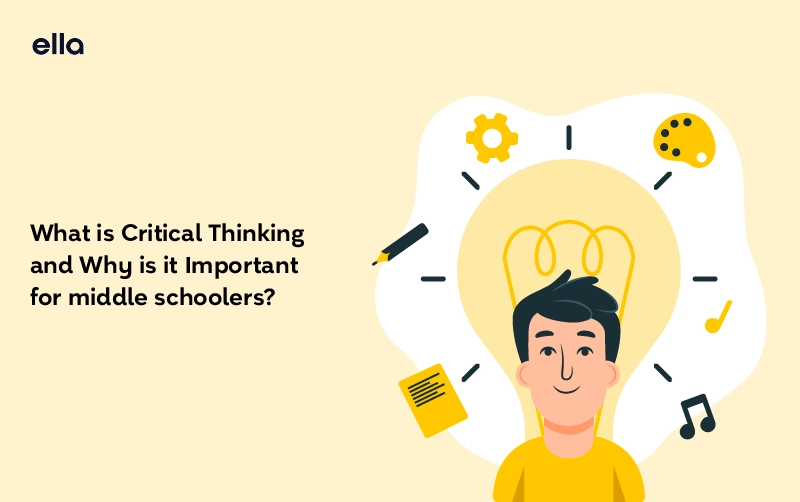Students who have mastered the art of critical thinking are at a big advantage in life. When presented with new information, a good critical thinker can quickly analyze it and make sound decisions.
Contrary to popular belief, critical thinking is not a God-given talent, rather it is a skill that can be developed and honed through extensive practice. Therefore, educators agree that it’s important to start practicing critical thinking skills early in life, so that by the time they graduate, they will have developed a solid foundation during their school years.
The ability to think critically is more important than ever as middle schoolers enter puberty and face increasingly complicated issues. This article will define critical thinking, explain why it is crucial for high school students, and offer suggestions on how educators may foster students’ critical thinking abilities in the classroom.
What is critical thinking?
The ability to think critically encompasses the ability to analyze information, evaluate evidence, compare it to one’s past experiences, and finally, to make sound decisions based on the available information. It goes beyond rote memorization or simple recall of facts and requires students to engage in a deeper level of thinking. Critical thinkers can quickly analyze a problem, whether or not they have any past experience with a problem of that nature.
Middle schoolers need to be able to think critically because they are learning more complex subjects and dealing with more complicated problems. They can improve their ability to learn and solve problems by thinking critically.
Why Critical Thinking is Important for Middle Schoolers
Middle school is a time of significant growth and development for students, both physically and mentally. Physically, a person’s body grows more during adolescence than in any other period in life (except for infancy). Furthermore, they are beginning to form their own opinions and identities, and they are being exposed to a broader range of ideas and perspectives. Critical thinking is critical in assisting them in making sense of all of this new information. Some of the advantages of critical thinking for middle school students include:
- Problem-solving: Critical thinking enables students to analyze problems and find solutions. They can break down complex problems into smaller parts and figure out what needs to be done to solve them.
- Decision-making: Students can evaluate different options and make informed decisions by using critical thinking. They can weigh the benefits and drawbacks of each option and select the best one.
- Creativity: Critical thinking encourages students to think outside the box and come up with new ideas. It allows them to see things from various perspectives and connect disparate pieces of information.
- Academic success: Critical thinking is a necessary skill for success in all academic subjects. It assists students in comprehending complex concepts, analyzing information, and effectively communicating their ideas.
How to Encourage Critical Thinking in Middle Schoolers
Critical thinking skills require practice, but there are numerous strategies and techniques that teachers can use to assist students in developing this skill. Here are some ideas for fostering critical thinking in middle school students:
- Ask open-ended questions: Instead of asking yes or no questions, ask questions that require students to think more deeply. Instead of asking, “Did you like the book?” ask, “What did you find most interesting about the book?”.
- Encourage debate: Debate is an excellent way to help students develop critical thinking skills. Students learn to consider multiple perspectives and make connections between different pieces of information when they discuss various perspectives and ideas.
Using real-world examples helps students understand how critical thinking applies to their daily lives. To demonstrate various aspects of critical thinking, you can use current events, case studies, or examples from literature or history. - Model critical thinking: Teachers can model critical thinking by talking through their own thought processes and asking critical thinking questions. This demonstrates to students how critical thinking works in practice.
Addressing Common Challenges in Teaching Critical Thinking
Teaching critical thinking can be difficult, especially with middle school students whose cognitive abilities are still developing. Here are some common challenges that teachers may face, as well as solutions to them:
- Overcoming resistance: If students are used to more passive forms of learning, they may be resistant to critical thinking. It is critical to explain the importance of critical thinking and how it benefits them.
- Gradually develop skills: Because critical thinking skills develop gradually, it is important to begin with simpler tasks and gradually progress to more complex ones.
- Structure and flexibility must be balanced: Teachers must strike a balance between providing structure and allowing for flexibility. Giving students guidelines and frameworks can help them understand how to approach problems, while allowing them some flexibility allows them to be creative and explore different options.
- Diverse perspectives: Diverse perspectives help students understand that there are multiple ways to think about a problem. This allows them to develop empathy and appreciate different points of view.
- Giving feedback: Giving feedback is critical for helping students develop critical thinking skills. Teachers can provide feedback on students’ thought processes, assist them in identifying their strengths and weaknesses, and guide them in their efforts to improve.
Conclusion
Critical thinking is a crucial skill for middle schoolers to develop. By analyzing information, thinking deeply, and making good decisions, students can succeed in school and in life. Teachers can encourage critical thinking by asking open-ended questions, encouraging discussion, using real-world examples, modeling critical thinking, and addressing common challenges. With practice and guidance, middle schoolers can become skilled critical thinkers who are prepared for success.

